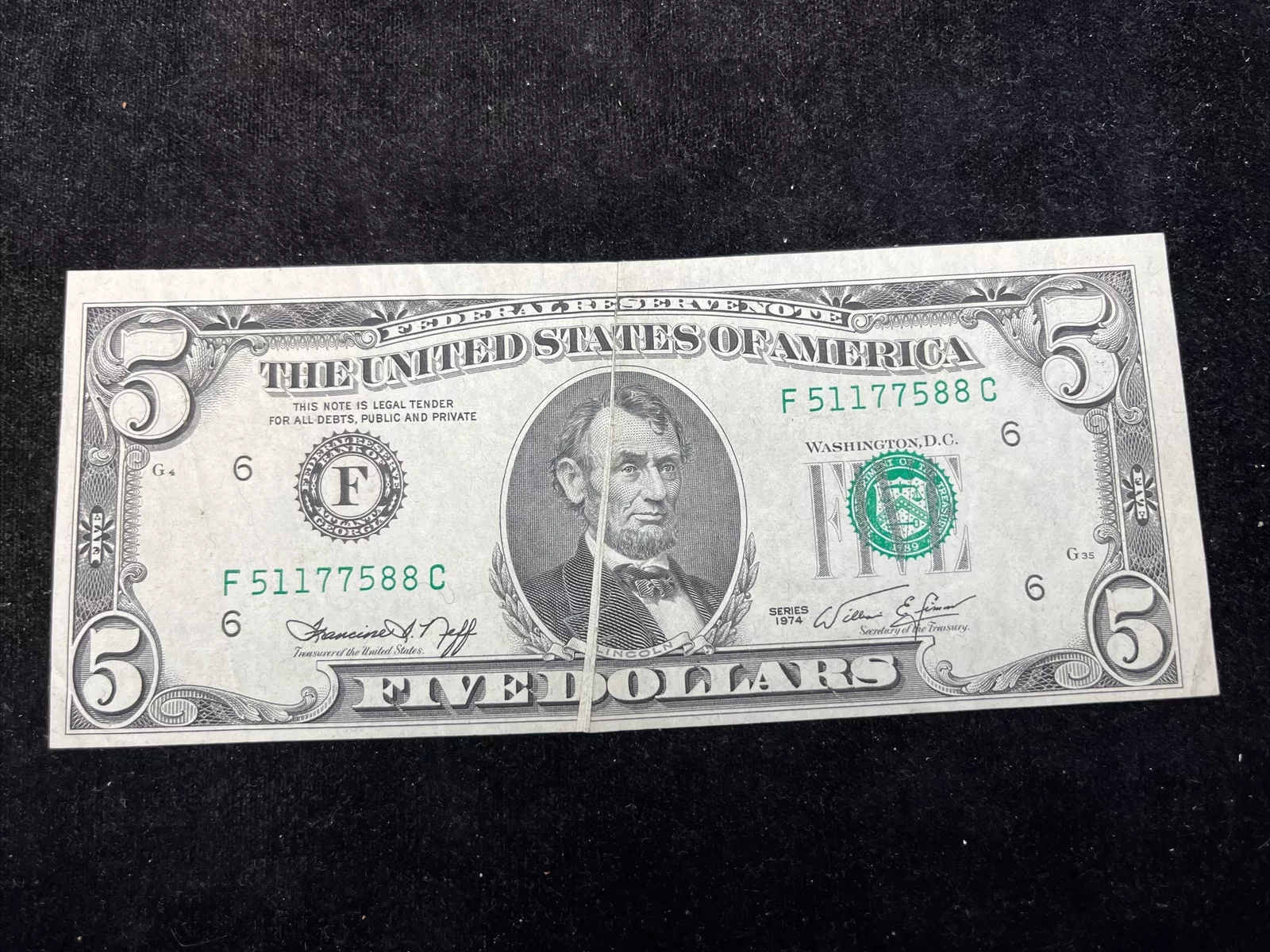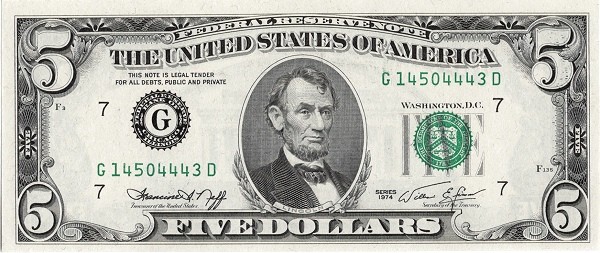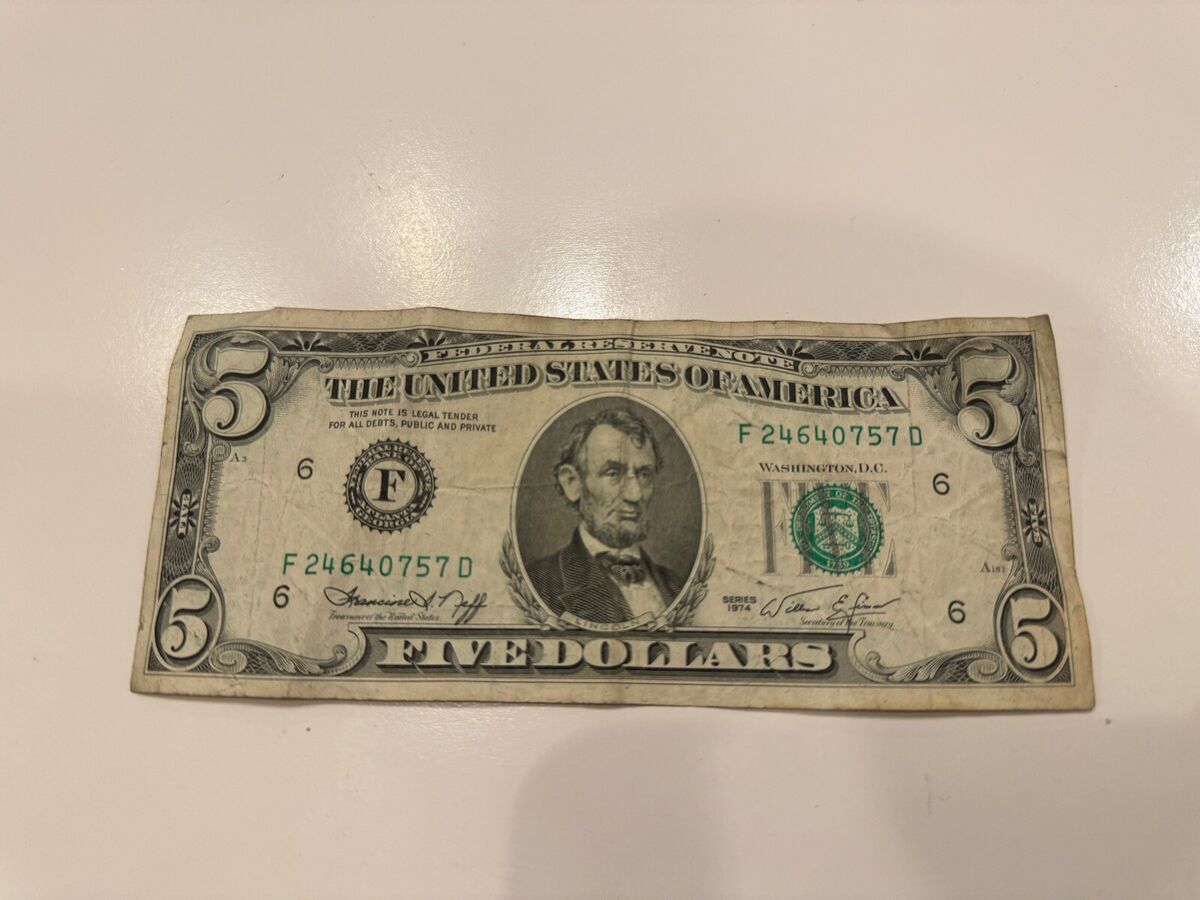If you’ve ever wondered about the 1974 5 dollar bill value, you’re not alone. Many collectors and currency enthusiasts come across these bills and want to know if they have any special worth beyond their face value.
While most 1974 $5 bills aren’t worth much more than the $5 they represent, there are exceptions.
The presence of star notes, the bill’s condition, and the series it belongs to can all play a significant role in determining its value.

So, if you’ve found a five dollar bill from 1974 or are curious about how much your 5 dollar bill might be worth, this article will help guide you through the process of determining its value.
Specifications of the 1974 $5 Bill
Before diving into the specifics of 1974 5 dollar bill value, it’s essential to understand the specifications of these bills. The 1974 $5 bill is part of the Federal Reserve Note series, with a green seal as is typical for most U.S. paper currency.
The 1974 series is a relatively modern issue, and the bills are commonly circulated, which is one of the reasons they don’t generally command very high values unless they are in excellent condition or have rare characteristics.
The 1974 $5 bill features a portrait of Abraham Lincoln on the front, accompanied by an image of the Lincoln Memorial on the back.
The signature combinations on the bill are Neff and Simon, reflecting the Treasury Secretary and the Treasurer of the United States at the time the bills were issued.
Despite being relatively modern, these bills can still have some collectible value, especially in uncirculated condition or if they happen to be star notes.
General Value of the 1974 $5 Bill
The 1974 5 dollar bill value generally depends on its condition and any unique features. For the most part, bills from the 1974 series are worth only a small premium over their face value unless they are in exceptional condition or are a special variety such as star notes.
Circulated Condition
For most bills from the 1974 series, those in circulated condition will generally be worth around $5 – the face value of the bill. These bills have been used in daily transactions, and as a result, they might show signs of wear, such as creases, folds, and light smudges.
If the bill is in very fine condition, with no significant damage and only minor creases or folds, its value could increase slightly to around $7.
However, it is unlikely that a standard, circulated 1974 $5 bill will ever be worth much more than this.
Uncirculated Condition
The value of a 1974 $5 bill increases if the note is in uncirculated condition. Uncirculated bills are those that have never been used in transactions, meaning they have retained their original crispness and are free of creases, folds, or other signs of wear.
A 1974 $5 bill that has been graded MS 63, meaning it is choice uncirculated, can be worth around $12.50.
The condition is a key factor in determining the worth of these bills, with uncirculated notes commanding a much higher price than their circulated counterparts.
The Role of Star Notes in Determining Value
When it comes to 1974 5 dollar bill value, one of the most important features that can significantly increase the worth of the bill is the presence of a star note. Star notes are replacement bills that the U.S. Federal Reserve printed to replace those that were damaged or misprinted during production.

The star symbol at the end of the serial number is a clear indication that the note is a star note.
Value of Star Notes
Star notes are rare and highly collectible, so they tend to be more valuable than regular 5 dollar bills. For example, a 1974 $5 star note in very fine condition might be worth around $10 to $12.50. If the star note is uncirculated and in MS 63 condition, its value can rise to $35 to $40.
Moreover, the Federal Reserve Banks that issued the star notes can also influence the bill’s value. For example, star notes that were issued by the Federal Reserve Banks of Boston and St. Louis are often more valuable than those issued by other Federal Reserve Banks. The relative rarity of these notes makes them particularly attractive to collectors, and as a result, they can command a premium.
Grading System for the 1974 $5 Bill
Understanding the condition of your 1974 $5 bill is crucial for determining its value. The grading system for paper currency helps collectors and dealers evaluate the condition of a bill. The two most common grades for bills are very fine and MS 63 uncirculated.
- Very Fine (VF): A bill in very fine condition has been in circulation but has not been subjected to heavy use. It should still be relatively crisp, but it may show some light creases, folds, or minor smudges. A 1974 $5 bill in very fine condition is generally worth around $7, though the exact value will depend on other factors such as the series and whether it is a star note.
- MS 63 Choice Uncirculated: A bill graded as MS 63 has no signs of ever having been in circulation. It is well-centered, with no significant creases, folds, or other signs of wear. The bill retains its original crispness and is considered to be in excellent condition. A 1974 $5 bill in MS 63 uncirculated condition can sell for around $12.50, and star notes in this grade are worth even more.
What Makes Some Bills More Valuable?
Aside from the bill’s condition and whether it is a star note, other factors can affect the value of a 1974 $5 bill. Some error bills may also be worth more if they feature rare printing mistakes. Printing errors can include misprints, mismatched serial numbers, or other anomalies that make the bill unique. These error bills can be highly sought after by collectors, potentially increasing their value significantly.
Finding the Value of Your 1974 $5 Bill
If you have a 1974 $5 bill and want to know its exact value, the best way to determine its worth is to have it professionally graded.
Many currency dealers and auction houses offer grading services for bills, and having your bill evaluated by an expert can provide a more accurate estimate of its value. Have a regular $5 bill, a star note, or a bill with an error, getting a professional opinion can help you understand its worth.
You can also check recent auction prices for similar 1974 $5 bills to see how much they are selling for. Keep in mind that the condition of the bill, the presence of a star note, and the specific series will all play a role in determining its price.
Conclusion: What is the 1974 5 Dollar Bill Worth?
So, what is the final answer to the question, “What is the 1974 5 dollar bill value?” For the most part, 1974 $5 bills are worth around their face value of $5, especially if they are in circulated condition. However, if the bill is in uncirculated condition, it may fetch around $12.50. Star notes can increase the value of the bill, with prices for these rare notes reaching up to $40 for notes in MS 63 uncirculated condition.
The value of a 1974 $5 bill can also be impacted by the specific series and the issuing Federal Reserve Bank. Error bills, while not common, can also command a higher price depending on the rarity of the mistake. As with any collectible, the value of the 1974 $5 bill will ultimately depend on its condition, rarity, and the demand from collectors.
Whether you are a seasoned currency collector or someone who simply stumbled upon a five dollar bill from 1974, it’s important to evaluate the condition and features of the bill carefully. In most cases, the 1974 5 dollar bill is worth just a little more than its face value, but with the right star note or a rare error bill, your 5 dollar bill could be worth much more!

